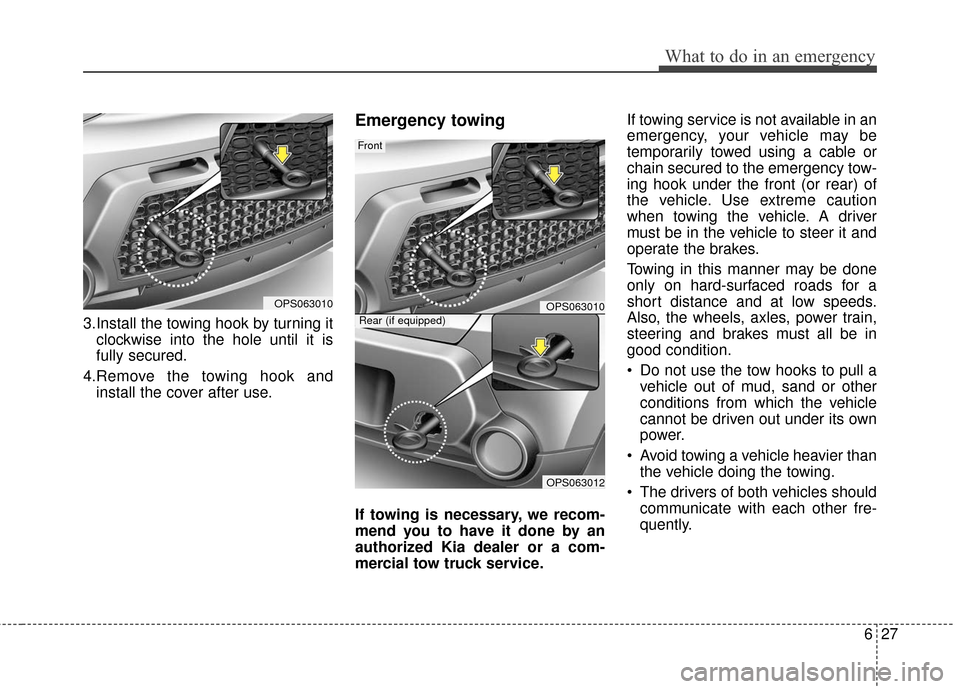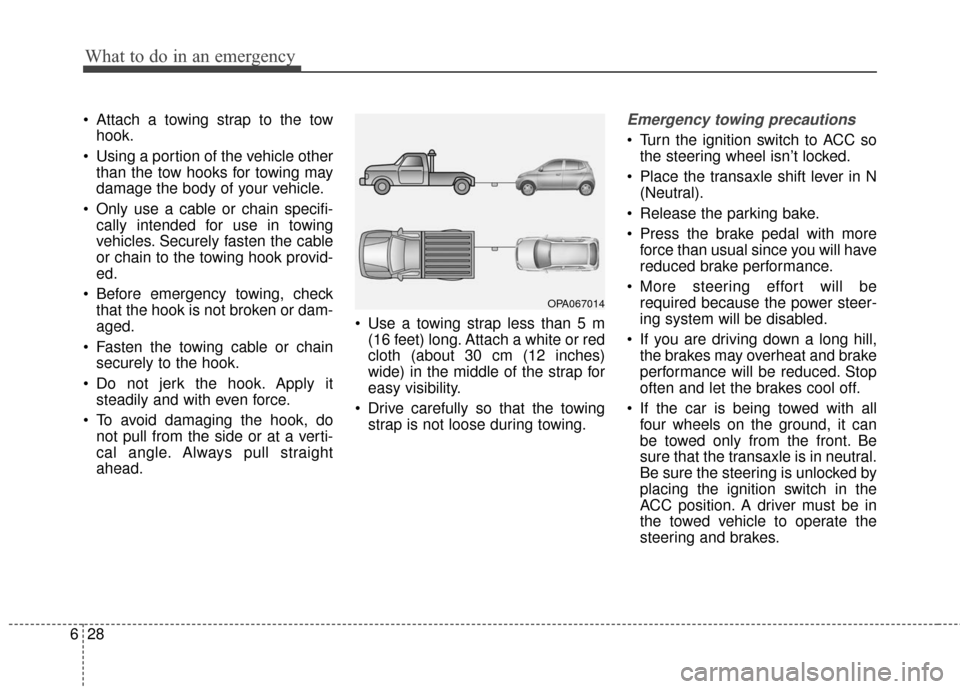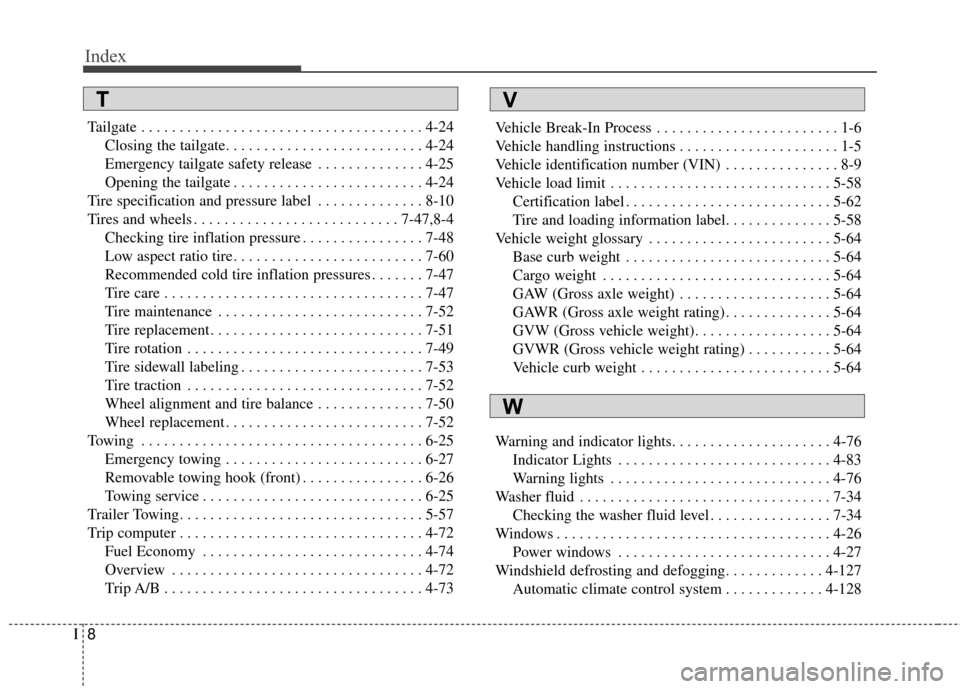Page 374 of 492

627
What to do in an emergency
3.Install the towing hook by turning itclockwise into the hole until it is
fully secured.
4.Remove the towing hook and install the cover after use.
Emergency towing
If towing is necessary, we recom-
mend you to have it done by an
authorized Kia dealer or a com-
mercial tow truck service. If towing service is not available in an
emergency, your vehicle may be
temporarily towed using a cable or
chain secured to the emergency tow-
ing hook under the front (or rear) of
the vehicle. Use extreme caution
when towing the vehicle. A driver
must be in the vehicle to steer it and
operate the brakes.
Towing in this manner may be done
only on hard-surfaced roads for a
short distance and at low speeds.
Also, the wheels, axles, power train,
steering and brakes must all be in
good condition.
Do not use the tow hooks to pull a
vehicle out of mud, sand or other
conditions from which the vehicle
cannot be driven out under its own
power.
Avoid towing a vehicle heavier than the vehicle doing the towing.
The drivers of both vehicles should communicate with each other fre-
quently.
OPS063010OPS063010
OPS063012
Front
Rear (if equipped)
Page 375 of 492

What to do in an emergency
28
6
Attach a towing strap to the tow
hook.
Using a portion of the vehicle other than the tow hooks for towing may
damage the body of your vehicle.
Only use a cable or chain specifi- cally intended for use in towing
vehicles. Securely fasten the cable
or chain to the towing hook provid-
ed.
Before emergency towing, check that the hook is not broken or dam-
aged.
Fasten the towing cable or chain securely to the hook.
Do not jerk the hook. Apply it steadily and with even force.
To avoid damaging the hook, do not pull from the side or at a verti-
cal angle. Always pull straight
ahead. Use a towing strap less than 5 m
(16 feet) long. Attach a white or red
cloth (about 30 cm (12 inches)
wide) in the middle of the strap for
easy visibility.
Drive carefully so that the towing strap is not loose during towing.Emergency towing precautions
Turn the ignition switch to ACC sothe steering wheel isn’t locked.
Place the transaxle shift lever in N (Neutral).
Release the parking bake.
Press the brake pedal with more force than usual since you will have
reduced brake performance.
More steering effort will be required because the power steer-
ing system will be disabled.
If you are driving down a long hill, the brakes may overheat and brake
performance will be reduced. Stop
often and let the brakes cool off.
If the car is being towed with all four wheels on the ground, it can
be towed only from the front. Be
sure that the transaxle is in neutral.
Be sure the steering is unlocked by
placing the ignition switch in the
ACC position. A driver must be in
the towed vehicle to operate the
steering and brakes.
OPA067014
Page 376 of 492
629
What to do in an emergency
CAUTION - Automatictransaxle
To avoid serious damage to the automatic transaxle, limitthe vehicle speed to 15 km/h(10 mph) and drive less than1.5 km (1 mile) when towing.
Before towing, check the auto- matic transaxle for fluid leaksunder your vehicle. If the auto-matic transaxle fluid is leak-ing, a flatbed equipment ortowing dolly must be used.
Page 491 of 492

Index
8I
Tailgate . . . . . . . . . . . . . . . . . . . . . . . . . . . . . . . . . . . . \
. 4-24Closing the tailgate. . . . . . . . . . . . . . . . . . . . . . . . . . 4-24
Emergency tailgate safety release . . . . . . . . . . . . . . 4-25
Opening the tailgate . . . . . . . . . . . . . . . . . . . . . . . . . 4-24
Tire specification and pressure label . . . . . . . . . . . . . . 8-10
Tires and wheels . . . . . . . . . . . . . . . . . . . . . . . . . . . 7-47,8-4 Checking tire inflation pressure . . . . . . . . . . . . . . . . 7-48
Low aspect ratio tire. . . . . . . . . . . . . . . . . . . . . . . . . 7-60
Recommended cold tire inflation pressures . . . . . . . 7-47
Tire care . . . . . . . . . . . . . . . . . . . . . . . . . . . . . . . . . . 7-47\
Tire maintenance . . . . . . . . . . . . . . . . . . . . . . . . . . . 7-52
Tire replacement . . . . . . . . . . . . . . . . . . . . . . . . . . . . 7-51
Tire rotation . . . . . . . . . . . . . . . . . . . . . . . . . . . . . . . 7-49
Tire sidewall labeling . . . . . . . . . . . . . . . . . . . . . . . . 7-53
Tire traction . . . . . . . . . . . . . . . . . . . . . . . . . . . . . . . 7-52
Wheel alignment and tire balance . . . . . . . . . . . . . . 7-50
Wheel replacement . . . . . . . . . . . . . . . . . . . . . . . . . . 7-52
Towing . . . . . . . . . . . . . . . . . . . . . . . . . . . . . . . . . . . . \
. 6-25 Emergency towing . . . . . . . . . . . . . . . . . . . . . . . . . . 6-27
Removable towing hook (front) . . . . . . . . . . . . . . . . 6-26
Towing service . . . . . . . . . . . . . . . . . . . . . . . . . . . . . 6-25
Trailer Towing. . . . . . . . . . . . . . . . . . . . . . . . . . . . . . . . 5-57
Trip computer . . . . . . . . . . . . . . . . . . . . . . . . . . . . . . . . 4-72 Fuel Economy . . . . . . . . . . . . . . . . . . . . . . . . . . . . . 4-74
Overview . . . . . . . . . . . . . . . . . . . . . . . . . . . . . . . . . 4-72
Trip A/B . . . . . . . . . . . . . . . . . . . . . . . . . . . . . . . . . . 4-73\
Vehicle Break-In Process . . . . . . . . . . . . . . . . . . . . . . . . 1-6
Vehicle handling instructions . . . . . . . . . . . . . . . . . . . . . 1-5
Vehicle identification number (VIN) . . . . . . . . . . . . . . . 8-9
Vehicle load limit . . . . . . . . . . . . . . . . . . . . . . . . . . . . . 5-58
Certification label . . . . . . . . . . . . . . . . . . . . . . . . . . . 5-62
Tire and loading information label. . . . . . . . . . . . . . 5-58
Vehicle weight glossary . . . . . . . . . . . . . . . . . . . . . . . . 5-64 Base curb weight . . . . . . . . . . . . . . . . . . . . . . . . . . . 5-64
Cargo weight . . . . . . . . . . . . . . . . . . . . . . . . . . . . . . 5-64
GAW (Gross axle weight) . . . . . . . . . . . . . . . . . . . . 5-64
GAWR (Gross axle weight rating) . . . . . . . . . . . . . . 5-64
GVW (Gross vehicle weight). . . . . . . . . . . . . . . . . . 5-64
GVWR (Gross vehicle weight rating) . . . . . . . . . . . 5-64
Vehicle curb weight . . . . . . . . . . . . . . . . . . . . . . . . . 5-64
Warning and indicator lights. . . . . . . . . . . . . . . . . . . . . 4-76 Indicator Lights . . . . . . . . . . . . . . . . . . . . . . . . . . . . 4-83
Warning lights . . . . . . . . . . . . . . . . . . . . . . . . . . . . . 4-76
Washer fluid . . . . . . . . . . . . . . . . . . . . . . . . . . . . . . . . . 7-34 Checking the washer fluid level . . . . . . . . . . . . . . . . 7-34
Windows . . . . . . . . . . . . . . . . . . . . . . . . . . . . . . . . . . . . \
4-26 Power windows . . . . . . . . . . . . . . . . . . . . . . . . . . . . 4-27
Windshield defrosting and defogging. . . . . . . . . . . . . 4-127 Automatic climate control system . . . . . . . . . . . . . 4-128
V
W
T